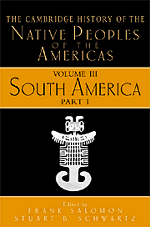Book contents
- Frontmatter
- Contents
- List of Illustrations
- Introduction
- 1 Testimonies: The Making and Reading of Native South American Historical Sources
- 2 Ethnography in South America: The First Two Hundred Years
- 3 The Earliest South American Lifeways
- 4 The Maritime, Highland, Forest Dynamic and the Origins of Complex Culture
- 5 The Evolution of Andean Diversity: Regional Formations (500 B.C.E.–C.E. 600)
- 6 Andean Urbanism and Statecraft (c.E. 550–1450)
- 7 Chiefdoms: The Prevalence and Persistence of “Señoríos Naturales” 1400 to European Conquest
- 8 Archaeology of the Caribbean Region
- 9 Prehistory of the Southern Cone
- 10 The Fourfold Domain: Inka Power and Its Social Foundations
- 11 The Crises and Transformations of Invaded Societies: The Caribbean (1492–1580)
- 12 The Crises and Transformations of Invaded Societies: Andean Area (1500–1580)
- 13 The Crises and Transformations of Invaded Societies: Coastal Brazil in the Sixteenth Century
- Index
9 - Prehistory of the Southern Cone
Published online by Cambridge University Press: 28 March 2008
- Frontmatter
- Contents
- List of Illustrations
- Introduction
- 1 Testimonies: The Making and Reading of Native South American Historical Sources
- 2 Ethnography in South America: The First Two Hundred Years
- 3 The Earliest South American Lifeways
- 4 The Maritime, Highland, Forest Dynamic and the Origins of Complex Culture
- 5 The Evolution of Andean Diversity: Regional Formations (500 B.C.E.–C.E. 600)
- 6 Andean Urbanism and Statecraft (c.E. 550–1450)
- 7 Chiefdoms: The Prevalence and Persistence of “Señoríos Naturales” 1400 to European Conquest
- 8 Archaeology of the Caribbean Region
- 9 Prehistory of the Southern Cone
- 10 The Fourfold Domain: Inka Power and Its Social Foundations
- 11 The Crises and Transformations of Invaded Societies: The Caribbean (1492–1580)
- 12 The Crises and Transformations of Invaded Societies: Andean Area (1500–1580)
- 13 The Crises and Transformations of Invaded Societies: Coastal Brazil in the Sixteenth Century
- Index
Summary
The Southern Cone is the great triangular landmass extending from the edges of the Central Andean high plateaus southward to Tierra del Fuego (see Map 9.1). Under familiar social-evolutionist assumptions, this vast space has often been called “marginal” because nearly all of it lay outside the political realm of the Inka and because, in general, its native societies operated with simple technologies and small populations. In suggesting more nuanced images, we differentiate among five component spaces. First, at the northern edge of this macroregion, we distinguish a region that we call the South-Central Andes. It comprises northern Chile, northwestern Argentina, and part of southern Bolivia. Here social complexity took shape relatively early (1500 B.C.E.–C.E. 1450), and here too Inka rule eventually penetrated. It makes sense to consider the South-Central Andes’s prehistory over the long term as dynamically linked with Andean developments proper. On the other hand, groups living in the huge spaces south and east of the South-Central Andes experienced different processes and produced social forms fundamentally dissimilar from those of the Andes. These are the peoples to which the “marginal” rubric has most stubbornly adhered. They inhabited four spatial units comprising the Southern Cone proper: the Chaco, the Pampas, Araucania, and Patagonia.
The purpose of this work is to afford a prehistoric vision of the peoples of these territories, starting from the moment when their societies began to build social complexity by using a technology that allowed domestication of the environment. In absolute chronological terms, this includes a period from 1000 B.C.E. up to the fifteenth century C.E. The extreme environmental diversity of the Southern Cone – which includes every thing from high deserts to forested fjords – and the far-from-obvious relations between its environments and cultural processes, make a unitary treatment inappropriate. The processes that led to agriculture and animal domestication in the South-Central Andes occurred differently or not at all in the rest of the Southern Cone. Ceramic and copper metalwork developed briskly in some of its areas, but in Patagonia they were unknown. Copper metallurgy, which in the arid north of Chile took shape about as early as it did in the Old World (more than 1,000 years B.C.E.), arose there not out of any obvious adaptive process but as part of a sumptuary complex reinforcing rituals. In some cases although people knew of these techniques and could have practiced them, their adaptations did not require incorporating them. Other prehistoric processes were no less uneven.
- Type
- Chapter
- Information
- The Cambridge History of the Native Peoples of the Americas , pp. 734 - 768Publisher: Cambridge University PressPrint publication year: 1999
- 4
- Cited by



